In the ever-evolving digital landscape, testimonials emerge not only as reflections of consumer satisfaction but as powerful catalysts for building credibility and driving conversions. As businesses strategically integrate testimonials into their online presence, backed by the insights of experts and the compelling evidence of statistics, a new era of consumer trust and engagement unfolds—one where authenticity reigns supreme, shaping the digital narrative and propelling brands towards sustained success.

The Difference Between Reviews and Testimonials:

Source: Orbitmedia
1. Defining Reviews: The Candid Voice of the Masses
- Nature: Reviews are typically unsolicited opinions shared by customers based on their experiences with a product, service, or business.
- Authenticity: They often come from a diverse range of customers, providing a candid and collective perspective on various aspects.
2. Defining Testimonials: Personal Endorsements from Satisfied Customers
- Nature: Testimonials are curated, positive statements crafted by satisfied customers to express their personal experiences and satisfaction.
- Authenticity: They are generally more polished and focused on highlighting specific positive aspects of the product or service.
3. Source and Presentation: Public vs. Purposeful
- Reviews: Usually found on third-party platforms, review sites, or public forums where customers share feedback organically.
- Testimonials: Often solicited and presented by businesses on their official website, marketing materials, or promotional content.
4. Purpose: Public Validation vs. Brand Endorsement
- Reviews: Serve as public validation, helping prospective customers make informed decisions based on collective opinions.
- Testimonials: Function as brand endorsements, strategically selected and presented to showcase positive experiences and build trust.

5. Tone and Detail: Candid vs. Curated
- Reviews: Tend to be more candid, featuring a range of tones and varying levels of detail.
- Testimonials: Generally curated to highlight specific positive experiences, often with a more polished tone.
6. Impact on Brand Perception: Community Validation vs. Strategic Influence
- Reviews: Shape the overall reputation of a brand based on collective opinions, influencing how it is perceived in the market.
- Testimonials: Strategically crafted to influence potential customers positively, contributing to a brand’s narrative and perceived value.
7. Handling Negative Feedback: Community Response vs. Internal Management
- Reviews: Businesses often respond publicly to negative reviews, addressing concerns and showcasing commitment to customer satisfaction.
- Testimonials: Negative experiences are typically handled internally, with testimonials serving as a platform to accentuate positive aspects.
Top Testimonial Plugins for WordPress
1. Real Testimonials

- Features:
- Five layouts for displaying testimonials.
- Ten customizable themes for testimonial cards.
- Video type with a lightbox for dynamic content.
- Customizable testimonial submission form.
- Email notifications for new feedback submissions.
Why It Stands Out: Real Testimonials stands out for its diverse layouts, customizable themes, and the inclusion of a video type for a more engaging user experience. The ability to modify submission forms and receive notifications adds to its user-friendly features.
2. JetReviews
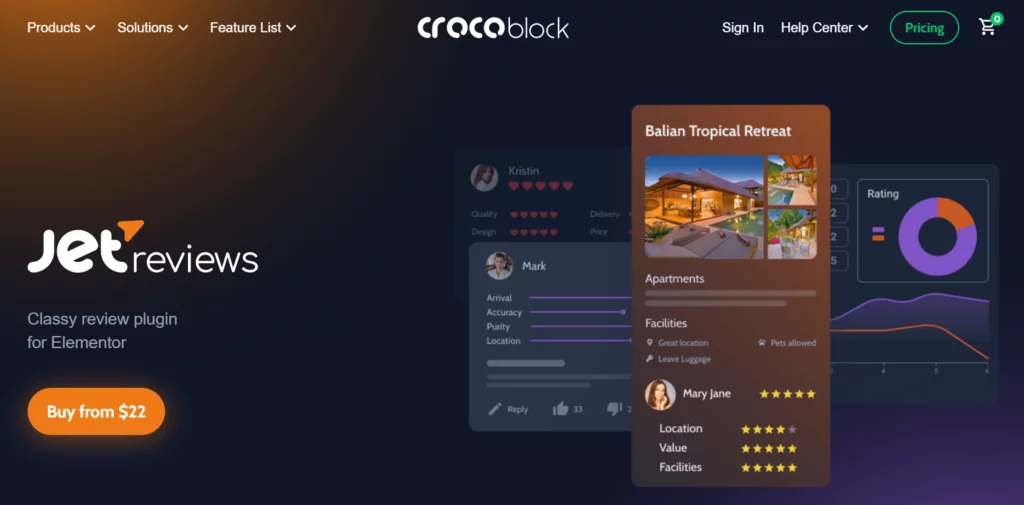
- Features:
- Different review types for various post categories.
- User interactivity with upvoting, downvoting, and replies.
- Evaluation criteria (Service, Price, Location, etc.) for reviews.
- Fetch average ratings where needed.
- Backend rating dashboard for admin statistics.
Why It Stands Out: JetReviews offers a unique interactive experience, allowing users to engage with reviews through upvotes, downvotes, and replies. The ability to customize static testimonial and integrate with other Crocoblock Subscription plugins enhances its functionality.
Learn about negative feedback here.
3. JetElements

- Features:
- Testimonials widget among 45 Elementor widgets.
- Freedom in displaying various layouts and designs.
- Manual addition or dynamic fetching from meta fields.
- Fully responsive with customization for different devices.
Why It Stands Out: JetElements provides a comprehensive plugin with 45 widgets, and Testimonials is just one of its offerings. The freedom it offers in adjusting layouts and designs, along with responsiveness and dynamic fetching, makes it a versatile choice.
4. WP Review Slider
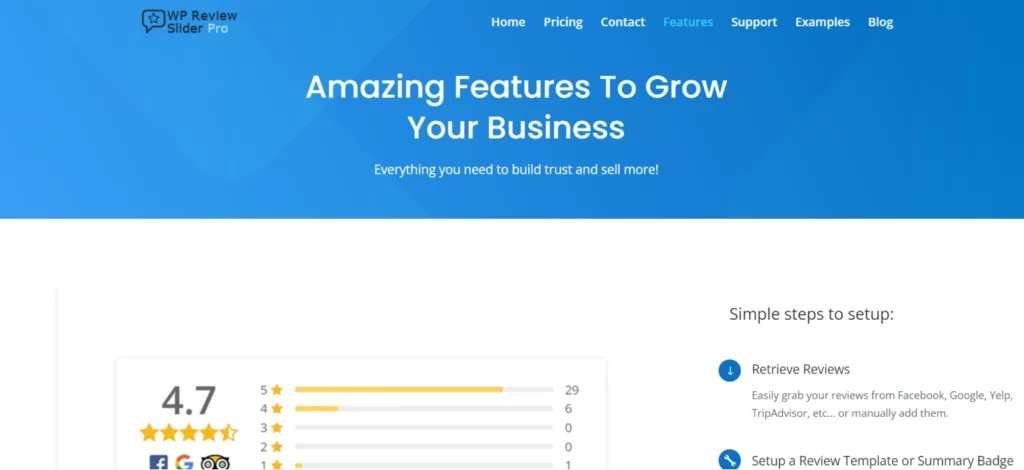
- Features:
- Grabs reviews from Google, Facebook, Yelp, and more.
- Customizable layout options (slider, grid, pop-up, floating badge).
- Display average rating badge.
- Manual testimonials and website submission form.
Why It Stands Out: WP Review Slider simplifies the process of gathering reviews from various platforms and customizing their display. The inclusion of a website submission form adds flexibility, making it a comprehensive solution.
5. Smart Slider
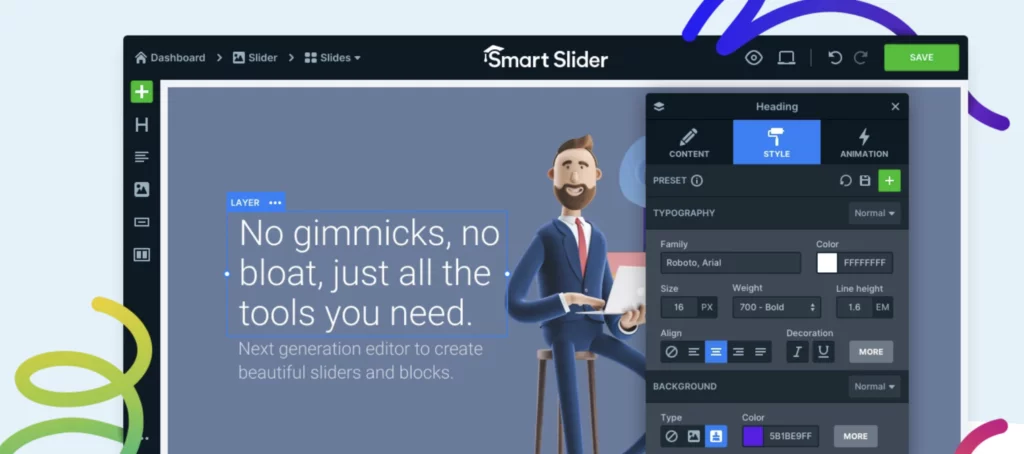
- Features:
- No coding required for creating testimonial sliders.
- Layout customization for mobile screens.
- Visual editing with drag-and-drop ease.
- Ready-made templates for quickstart.
- Transformative testimonial sliders for added engagement.
Why It Stands Out: Smart Slider 3 emphasizes ease of use with no coding required. It provides visually appealing testimonial sliders that are easily customizable, making it accessible for users with varying technical expertise.
Successful Examples of Website Testimonials:
1. Big and Detailed Testimonials Slider: Sun King Company

Sun King Company uses a full-screen slider that combines a large photo and a map. This approach effectively showcases the regions where the company provides off-grid solar systems. The design is immersive and aligns seamlessly with the overall website, providing visitors with a visually compelling narrative of the company's impact and the genuine emotions of satisfied customers.
Key Features:
- Large, full-screen imagery.
- Integration of a map for geographical context.
- Contextual representation of regions and emotions.
2. Stylish Testimonials Slider in Main Page Design: Content Coms Company

Content Coms Company integrates stylish testimonials into its main page design through slider blocks. These testimonials occupy significant screen space, displaying names, job positions, and company affiliations. The design not only aligns with the company's commitment to a carbon-conscious world but also showcases their proficiency in content presentation.
Key Features:
- Stylish slider blocks.
- Full-width and at least half-screen height.
- Inclusion of names, job positions, and company affiliations.
3. Straightforward Reviews in a Speech Bubble: Digital Global Marketing Agency

The Digital Global Marketing Agency presents straightforward reviews in speech bubbles on its website. Names of individuals, specific services used, and achieved goals are clearly stated. This design choice complements the overall website aesthetic and contributes to an atmosphere of friendliness and transparency.
Key Features:
- Speech bubble design.
- Inclusion of names, services used, and goals achieved.
- Consistent with the website's friendly atmosphere.
4. Minimalistic and Elegant Slider: Custom Seafoods
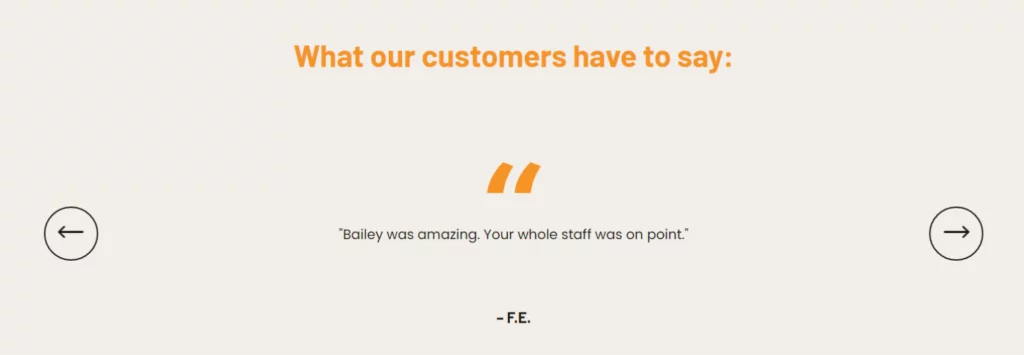
Custom Seafoods employs a minimalistic and elegant testimonial slider, complementing the overall website design characterized by bold orange accents. Omitting full names emphasizes minimalism, which is suitable for a context where personal details might not be the primary focus.
Key Features:
- Minimalistic and elegant design.
- Bold orange accents for consistency.
- Omission of full names for a focus on simplicity.
5. Thematically Designed Tiles: Stonehouse Day Spa Salon
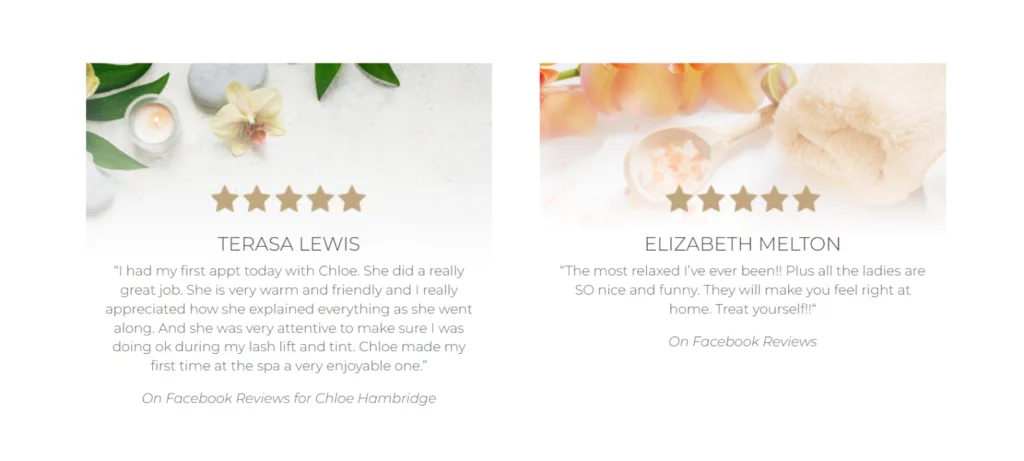
Stonehouse Day Spa Salon maintains a consistent theme with soft pastel tones on its website, extending to the testimonial section. Notably, the salon integrates reviews from third-party sources like Facebook and Google, adding credibility and providing specific details about staff and services.
Key Features:
- Consistent thematic design with soft pastel tones.
- Integration of reviews from third-party sources.
- Inclusion of specific details about staff and services.
6. Video Testimonials: Smart Passive Income

Smart Passive Income's website, centered around podcasts, online courses, and marketing instruments, incorporates video testimonials. While challenging to obtain, video testimonials add a dynamic and credible element, aligning seamlessly with the website's emphasis on audio and video content.
Key Features:
- Integration of video testimonials.
- Dynamic and credible content.
- Alignment with the website's focus on audio and video content.
7. Testimonial Page with Filters and Different Layouts: Marie Forleo's Online Business School
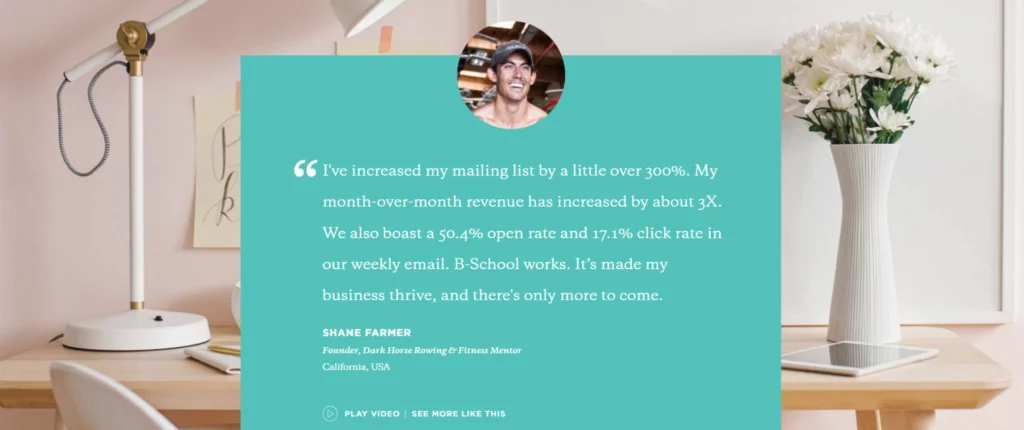
Marie Forleo's Online Business School takes testimonials to another level with a versatile approach. Testimonials are strategically placed on almost every page, featuring different layouts and styles. The inclusion of filters provides visitors with a customizable and engaging testimonial experience, highlighting the diversity and impact of their online courses.
Key Features:
- Testimonials integrated across various pages.
- Different layouts and styles for versatility.
- Inclusion of filters for a customizable user experience.
Common Mistakes in Website Testimonials: Avoiding Pitfalls for Credibility
1. Demo Testimonials Content:
- Surprising yet Prevalent: One of the most surprising and unfortunately common mistakes is the use of demo content from review plugins.
- Celebrities and Stylized Photos: Websites, even those of reputable companies, often leave default content featuring celebrities with perfectly-stylized photos.
- Neglect from Professionals: Even web or marketing agencies, despite their specialization, may neglect this section, potentially repelling clients.
2. Fake or Self-Composed Testimonials:
- Noticeable Differences: Resorting to fake or self-composed testimonials, even if well-intentioned, can result in noticeable differences.
- Diminished Trustworthiness: Authentic customer insights stand out, and the difference between genuine reviews and manufactured praise can diminish the overall trustworthiness of this section.
3. Lack of Client Information:
- Crucial Context for Specialized Websites: Failing to provide essential information about clients can be a significant drawback, especially for websites with a narrow specialization.
- Contextual Details: For example, a language school might benefit from showcasing the age, profession, and specific course of the person providing the testimonial.
- Relevance in SaaS Companies: In the case of SaaS companies, knowing the testimonial author's position and department adds crucial context.
4. Overlooking Industry-Specific Details:
- Narrow Specialization: Some websites, particularly those with narrow specializations, may require industry-specific details to enhance the testimonial's relevance.
- Tailoring Information: Consider the industry and tailor the information accordingly to make the testimonials more impactful and relatable.
5. Ignoring the User Experience:
- Paying Attention to Details: Meticulous attention to detail and a thoughtful approach to the client's experience are critical when designing and organizing this section.
- User-Focused Design: Ensure that the testimonials not only showcase positive feedback but also contribute to an overall positive user experience on the website.
6. Lack of Diversity:
- Diverse Perspectives: Represent a variety of client demographics, experiences, and backgrounds to showcase a diverse range of perspectives.
- Inclusivity: Emphasize inclusivity to demonstrate that your product or service is beneficial and valuable to a broad audience.
Conclusion:
In summary, website testimonials play a pivotal role in establishing trust and credibility with potential customers. To maximize their impact, designers and developers should carefully consider design elements. The plugins discussed in this context offer a variety of features to ensure that these are not only displayed attractively but also engage users, creating a positive impression on visitors. Elevate your website's testimonial section by leveraging these plugins, transforming customer feedback into a potent marketing tool.
FAQs on Testimonial Plugin:
Can negative feedback be included in testimonials?
Testimonials are typically designed to showcase positive experiences. However, some businesses may choose to address constructive criticism separately to demonstrate transparency and responsiveness.
How frequently should testimonials be updated?
Regularly updating testimonials keeps your content fresh. Aim for a schedule that aligns with your business growth or the introduction of new products or services.
Can testimonials be verified for authenticity?
While it may be challenging to verify every testimonial, businesses can build trust by showcasing a diverse range of testimonials and encouraging clients to share their genuine experiences.



